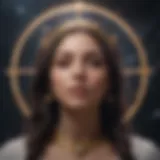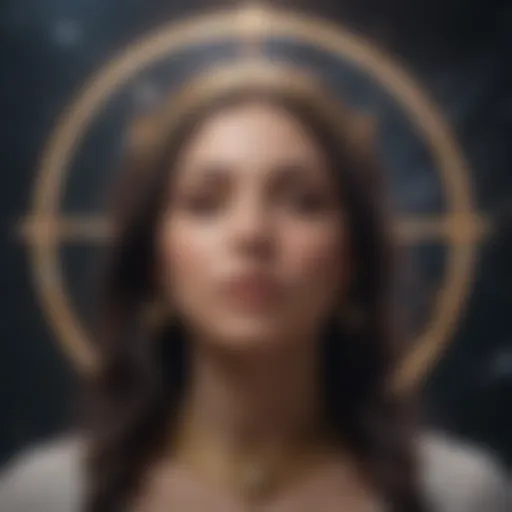Exploring Tarot Card Reading: History and Insights
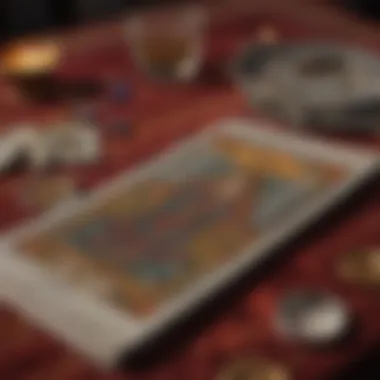

Intro
When stepping into the arena of tarot card reading, one finds themselves enveloped in a tapestry woven from threads of mystique, history, and personal insight. This ancient practice goes beyond simple fortune-telling; it is a profound tool of introspection and understanding. Within this article, we shall traverse the winding paths of tarot, unveiling the essential elements that highlight its significance in both yesterday's world and today's fast-paced life. As we navigate through the multitude of card meanings, spreads, and personal interpretations, we’ll touch on how the tarot serves as a bridge connecting the seeker to their inner self and to the cosmos.
A remarkable facet of tarot lies in its rich historical roots, which provide context for its contemporary relevance. It stands as a poignant reminder of humanity's perpetual quest for understanding, a quest that transcends time and culture. Readers, whether new to tarot or seasoned practitioners, will find nuggets of wisdom and insight woven throughout each section. Allow the allure of tarot to draw you in, as we embark on this insightful journey.
Foreword to Tarot Reading
The realm of tarot card reading fascinates many with its rich history and multifaceted applications. As we dive deep into this subject, understanding its foundational concepts becomes essential. This section will address the significance of tarot reading in our lives, illuminating its potential for personal introspection and decision-making.
Defining Tarot Card Reading
Tarot card reading is not merely about fortune-telling; it’s an intricate craft that weaves layers of symbols, meanings, and psychological insights. At its core, tarot involves a unique deck of cards, typically consisting of 78 cards, which are divided into two primary sections: the Major Arcana and Minor Arcana. Each card is imbued with a wealth of symbolism, serving as a mirror reflecting the reader's and querent's thoughts, feelings, and experiences.
While the art of tarot may seem esoteric, it essentially revolves around facilitating deep conversations—both with oneself and others. Readers employ intuition and symbolic knowledge to interpret the cards drawn, leading to personal revelations or clarity in various aspects of life.
The Purpose of Tarot Readings
The purpose of tarot readings transcends the immediate allure of prediction. Instead, they operate as a tool for deeper understanding. Here are a few key objectives often associated with tarot readings:
- Self-Reflection: Tarot prompts individuals to explore their innermost thoughts, often revealing truths that were previously overlooked.
- Decision-Making Aid: Many turn to tarot for guidance during critical junctures in their lives, facilitating informed decisions based on introspection.
- Therapeutic Insights: An emerging trend is utilizing tarot as a therapeutic tool. The symbolic nature of cards can uncover subconscious issues and generate dialogue about one’s emotional state.
In summary, tarot readings offer a roadmap not just for the future, but for understanding the present and decoding past experiences. This clarity can be invaluable in today’s fast-paced world, where introspection often takes a back seat. Through its exploratory nature, tarot allows us to peel back the layers of our psyche, granting us a clearer vision of our paths ahead.
Historical Background of Tarot
Understanding the historical background of tarot is crucial, as it lends depth and nuance to our comprehension of the cards today. The origins and evolution of tarot illuminate how different cultures adopted and adapted these mystical tools, shaping what they represent in contemporary readings. Without grasping this context, one may overlook the complexity embedded in tarot's imagery and symbolism, which have been preserved and transformed over centuries.
Origin of Tarot Cards
The origins of tarot cards date back to the early 15th century in Europe, primarily in Italy. Initially, they were not instruments of divination but were akin to playing cards used for games. The earliest references to tarot can be found in records from the court of the Duke of Milan, around the time of the Renaissance. It was during this period that these decks, consisting of four suits and a set of trumps, began to gain more structured and symbolic meanings.
"To understand tarot is to understand a bridge between the past and the present. Each card carries echoes of ancient wisdom, woven through various cultural threads."
However, like many elements within esoteric traditions, the exact origins remain somewhat murky. Some historians suggest a connection to ancient Egyptian hieroglyphs or even the Kabbalistic teachings from Jewish mysticism. The link to Egyptian roots, while intriguing, lacks substantial evidence. Instead, the consensus illustrates that its early iterations were primarily practical gaming cards.
Over time, tarot began to evolve beyond mere entertainment. By the late 18th century, tarot decks were created with artistic and esoteric connotations. Leading figures like Antoine Court de Gébelin proposed that the tarot cards represented profound mystical truths, aligning them with Kabbalistic teachings. This sparked a flurry of interest and investigations into the symbolic language of tarot, stimulating its transition into a tool for mystical insight rather than just a game.
Evolution Through the Ages
As time progressed, tarot cards experienced transformations coinciding with cultural and societal changes. The emergence of the occult in the 19th century brought a more structured approach to interpreting the cards. The work of individuals like Rachel Pollack and Arthur Edward Waite solidified tarot's role in psychic readings and introspective practices.
Different styles of tarot decks emerged, each tailored to the beliefs and values of their respective creators. For instance, the Rider-Waite-Smith deck, introduced in 1910, set a standard in modern tarot reading with its vivid imagery and detailed illustrations, making it accessible to new practitioners. Each card transformed into less of a random draw and more of a storytelling medium, each telling a specific narrative aligned with our psyche and life journey.
In the contemporary context, tarot has expanded its relevance beyond fortune telling into realms like therapy, personal development, and self-exploration. Esoteric communities appreciate its ability to tap into the unconscious, utilizing it to foster a deeper understanding of life’s challenges and opportunities. Tarot reading has morphed into a method of reflection and guidance, bridging the ancient wisdom with today's pragmatic needs.
In summary, the historical trajectory of tarot from its origins as a playful pastime to its revered role in metaphysical practice reveals its adaptability and cultural significance. This journey not only enriches our reading practice but also deepens our connection to the wisdom these cards convey.
Understanding the Structure of a Tarot Deck
Understanding the structure of a tarot deck is crucial for anyone looking to navigate the intricate world of tarot reading effectively. A tarot deck typically comprises 78 cards, each teeming with symbolism, archetypes, and narratives that provide insight and guidance. Knowing how these cards are organized allows both readers and querents alike to harness the full potential of the cards during a reading. Whether you're a seasoned reader or just starting, having a solid grasp of this structure enhances not only the interpretation skills but the overall experience.
Major Arcana: The Key Archetypes
The Major Arcana cards, numbering 22, represent significant life events, spiritual lessons, and deep insights. Each card, from The Fool to The World, encapsulates vital archetypes that resonate with universal human experiences.
- The Fool: Embodies beginnings and spontaneity. This card signifies leaps of faith and new journeys.
- The Magician: Symbolizes resourcefulness and power, encouraging individuals to tap into their inner potential.
- The High Priestess: Represents intuition and the unconscious mind, urging one to listen to their inner voice.
These archetypes function as guiding lights in any reading, helping seekers understand their life's purpose and the spiritual lessons that may arise.
Minor Arcana: Detailed Insights
While the Major Arcana captures the monumental shifts in life's journey, the Minor Arcana focuses on the day-to-day events and experiences. Comprised of 56 cards, the Minor Arcana is divided into four suits: Cups, Pentacles, Swords, and Wands. Each suit deals with specific areas of life:
- Cups: Relate to emotions, relationships, and connections, shedding light on one's feelings.
- Pentacles: Concern material aspects, including finances and career, often addressing issues surrounding stability and growth.
- Swords: Focus on thoughts, challenges, and decisions, pointing to conflicts and truths that need acknowledgment.
- Wands: Embody inspiration, creativity, and action, representing one's drive and ambitions.
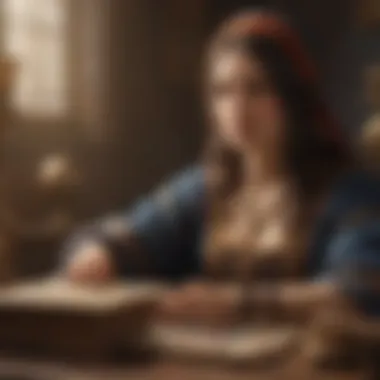

Within these suits, every card offers a unique perspective, allowing for a more nuanced and detailed narrative in any reading.
Court Cards: Interpersonal Dynamics
Court Cards emerge as the intermediaries between the Major and Minor Arcana, illustrating personalities and interactions. They provide a heavy dose of context, acting out interpersonal dynamics. The Court Cards are divided into four ranks: Page, Knight, Queen, and King.
- Pages: Often symbolize youth and new beginnings. They reflect curiosity and a willingness to learn.
- Knights: Embody action and pursuit, often moving toward their goals with vigor.
- Queens: Represent nurturing, wisdom, and intuitive understanding. They encapsulate emotional depth and stability.
- Kings: Symbolize authority and mastery, portraying control and balanced leadership.
Understanding these cards is essential for readers, as they can signify others in the querent's life or aspects of their personality, enriching readings with a multi-dimensional layer.
"The structure of a tarot deck is like a map of the psyche, each card a unique destination on the journey of self-discovery."
In summary, a comprehensive understanding of the structure of a tarot deck lays the groundwork for effective readings. Recognizing the distinct roles of the Major Arcana, Minor Arcana, and Court Cards fosters deeper insights and enhances the interpretation, making the experience profound and transformative.
The Art of Interpretation
Understanding the art of interpretation in tarot card reading is essential. It’s not just about memorizing card meanings; it’s about grasping the emotional and psychological nuance behind each reading. The reader takes on a pivotal role, connecting deeply with both the cards and the querent. This skill allows the reader to weave a narrative that resonates meaningfully with the individual seeking guidance.
The beauty of tarot lies in its poetic symbolism. Every image and detail in a tarot card delivers a story waiting to unfold. When you decode these symbols, you uncover layers of meaning that might relate to personal experiences or universal truths. This process fosters a profound bond between the reader and the cards, making each reading a unique journey towards insight.
Symbolism in Tarot Cards
One cannot overlook the significance of symbolism in tarot cards. Each card is adorned with rich imagery that conveys messages on various levels. Knowing that, it becomes vital for the reader to delve into these symbols. For example, the Tower card often signifies upheaval, while the Star represents hope and renewal. This nuanced interpretation goes beyond surface-level understanding.
Consider the following:
- Colors: Each hue carries emotional weight. For instance, blue might signify calmness and clarity, while red could indicate passion or conflict.
- Figures: Human figures can represent various archetypes, often mirroring aspects of the querent's life or personality.
- Nature Elements: Natural motifs often symbolize growth, change, or stagnation, depending on their context within a reading.
Viewing a card through these lenses not only enhances your interpretation but also enriches the querent’s understanding of their life situation.
Intuition and Insight in Readings
Another cornerstone of tarot interpretation is the role of intuition. While knowledge of card meanings lays a foundation, intuition adds a vibrant layer, turning a good reading into a great one. Readers must cultivate their intuitive sense to help them see beyond traditional meanings.
Trusting your gut can lead to profound insights that are often the heart of a reading. Sometimes, the energy of a situation eludes conventional interpretation but becomes crystal clear through intuitive understanding. For instance, you might draw the Empress, implying fertility and abundance, but your intuition might guide you to interpret this in a context of nurturing oneself rather than physical motherhood.
To harness this intuition, practice being present. Silence your mind and let the symbols of the cards ebb and flow through your consciousness. Take note of any feelings or thoughts that arise as you consider the querent's context within the reading.
Common Interpretative Methods
There’s no one-size-fits-all approach in tarot interpretation. Different methods exist, each providing unique insights. Here’s a brief overview of some popular methods that you might find beneficial:
- Rider-Waite System: Possibly the most recognized, this method emphasizes clarity and intuitive understanding. The imagery is designed to facilitate interpretation without extensive knowledge.
- Thoth Deck Interpretation: Aligned with Kabbalistic principles, this approach dives into deeper esoteric meanings, often preferred by experienced readers.
- Numerology and Astrology: These traditions can complement tarot by adding layers of meaning based on numerological and astrological contexts.
Ultimately, the right method is one that resonates with you. Experiment, refine your process, and, most importantly, let your connection with the cards guide you.
“The cards are your collaborators. They converse and create with you, unraveling stories sometimes lost to the chaos of daily life.”
How to Conduct a Tarot Reading
Conducting a tarot reading is both an art and a practice that calls on intuition, understanding, and preparation. It goes beyond merely drawing cards and interpreting their meanings; it’s about creating an experience that resonates with the individual seeking guidance. Proper conduct in tarot reading ensures that the reader is confident, prepared, and ethical, fostering a deeper connection with the client.
Preparing for a Reading
Before you even shuffle the cards, setting the stage for a tarot reading is essential. Preparation involves both the physical and mental space you create. Here’s how one can do this:
- Create a Comfortable Environment: A quiet and uplifting space can make a world of difference. Ensure the room is free from clutter and distractions. Lighting a candle or burning incense can help establish a serene atmosphere.
- Ground Yourself: Take a moment to center your thoughts. Deep breathing or mindfulness can ease nerves and sharpen your focus. This step is crucial, as you want to approach the reading with a clear mind and positive energy.
- Prepare Your Materials: Have your tarot deck ready, and consider any additional tools you might like to use, such as crystals or journals for notes. Keeping everything organized can streamline the process and reduce pre-reading jitters.
Selecting the Right Spread
Choosing an appropriate card spread can significantly influence the insight drawn from a reading. The spread acts as a map, guiding the reader through the narrative of the session. The choice should align with the questions posed by the querent. Some commonly used spreads are:
- The Three-Card Spread: This is simple yet effective, providing insights into past, present, and future connected to a specific issue.
- The Celtic Cross Spread: A more complex layout that examines a situation from multiple angles, ideal for deeper inquiries.
- The Relationship Spread: Focused on dynamics between two individuals, ideal for understanding personal connections.
Each layout serves different purposes and brings depth to the reading experience, thereby helping in enhancing the overall interpretation of the cards drawn.
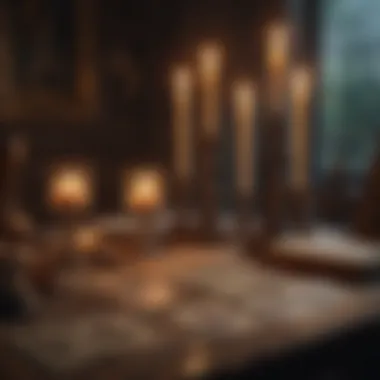

Engaging with the Cards
Engagement with the cards goes beyond observing images and symbols. It’s a process of connection, interaction, and communication. Here are several aspects of how to engage effectively:
- Intuitive Connection: As you draw each card, take a moment to feel its energy. This can lead to a more personal interpretation that resonates with the querent’s situation.
- Storytelling Approach: Think of each card as a part of a bigger narrative. How do they interact? What themes emerge? This method can help in weaving together the message.
- Encourage Dialogue: Invite the querent to share their interpretations or feelings about the cards. This might unveil insights that could easily be overlooked.
"Tarot is not just about giving answers; it’s about fostering self-reflection and helping individuals tap into their innate wisdom."
By dedicating time to preparations and interaction, you elevate the experience from a simple reading to a meaningful exchange. This enables both reader and querent to explore the depths of intuition and insight that tarot can offer.
Common Tarot Spreads
Understanding common tarot spreads is crucial for both novice and experienced readers. These spreads offer structured ways to interpret the cards and provide insights in various contexts, be it personal growth, relationships, or decision-making. Each spread has its own focus and can lead to different interpretations based on the querent's inquiries.
The Three-Card Spread
The Three-Card Spread stands out for its simplicity and versatility. It allows for a quick yet profound insight into issues, making it ideal for beginners and seasoned readers alike. Often, this spread represents three distinct aspects: past, present, and future. However, its flexibility enables interpretations beyond this traditional framework, allowing for deeper context or specific questions like situation, action, outcome.
- Past: This card sheds light on influences that have shaped the current situation.
- Present: The middle card offers a snapshot of the current state, revealing the querent's challenges or opportunities.
- Future: The third card hints at potential outcomes based on present actions.
Utilizing the Three-Card Spread promotes clarity and encourages a reflection on synchronicity. For instance, if the past card reveals The Tower, it can suggest a recent upheaval that may influence present choices represented by The Lovers. Meanwhile, the future card could be The Chariot, indicating movement forward after the chaos. This layered interpretation fosters nuanced discussions, making it a beloved choice among tarot aficionados.
The Celtic Cross Spread
The Celtic Cross Spread is often revered as one of the most comprehensive and insightful methods. It consists of ten cards, each occupying a specific position that contributes to a holistic view of the querent's inquiry.
- The Present Position: This card showcases the current situation.
- The Crossing Card: It represents obstacles or influences obstructing the querent.
- The Foundation: Indicates underlying influences from the past that affect the present.
- The Recent Past: Reflects events that have recently transpired.
- The Best Outcome: Suggests the best possible resolution, based on the current path.
- The Near Future: Offers insight into what is about to unfold.
- The Querent: This card shows the querent's role in the matter and their situation.
- External Influences: Represents how external factors affect the situation.
- Hopes and Fears: This card reveals the querent’s aspirations or anxiety regarding the situation.
- The Outcome: Indicates the potential end result based on current circumstances.
The depth of the Celtic Cross makes it exceptionally valuable for complex queries where layers of meaning are needed. The layout allows for a profound dialogue about challenges and resolutions, activating a deeper understanding of one's life.
The Relationship Spread
The Relationship Spread is tailored specifically for inquiries about interpersonal dynamics. This spread can illuminate the facets of a relationship, whether it’s romantic, friendship-based, or familial, helping both parties understand their respective roles and motivations.
This spread often features pairs of cards to represent each individual in the relationship, followed by cards revealing the relationship dynamics and challenges.
- Person A’s feelings: What they feel about the other party.
- Person B’s feelings: Their perception and emotions regarding Person A.
- The Current Dynamics: The third card highlights how both parties interact.
- Challenges: This card points to the main obstacles faced within the relationship.
- Advice for Improvement: Offers insight that may enhance the connection.
By dissecting the dynamics with care, this spread can untangle complex emotions and foster understanding. It addresses the notion of evenness and testing the waters of compromise, building pathways to reconnection.
"Tarot is not just about predicting the future; it can be a mirror reflecting our inner truths and relational nuances."
The Role of the Reader
In the realm of tarot, the reader occupies a pivotal position, one that's often overlooked. It's not merely a transaction of cards and meanings; it's an intricate dance between intuition, ethics, and interpersonal connection. The role of the reader can affect the experience and insights gained from a session. When we consider the multifaceted nature of this role, it's essential to unpack the nuances that define effective tarot reading.
Ethics in Tarot Reading
Ethics is the backbone of any profession, and tarot reading is no exception. A strong ethical foundation ensures that the reader approaches each session with integrity and respect. Not only does it protect the reader, but it also safeguards the client, fostering an atmosphere of trust.
First and foremost, confidentiality is key. A tarot reader often hears clients' personal stories and concerns. It's vital to uphold privacy, treating shared experiences as sacred trust. Without this respect, the very fabric of the reader-client relationship could unravel, leaving both parties feeling vulnerable and exposed.
Additionally, honesty is paramount. Readers should avoid exaggerating the significance of cards to fit a narrative or create false hope. Misleading a client can lead to emotional and psychological repercussions that last far beyond the reading itself. Instead, a reader should strive to provide clear insights and guidance, leaving room for client interpretation and agency.
Moreover, it’s important to recognize the limits of tarot. Readers should refrain from offering medical or legal advice. While insights drawn from a reading can shape perspectives, they should never replace professional counsel. Establishing this boundary can help clients feel more secure in the reading process.
Creating a Safe Space for Clients
Creating a safe space for clients involves more than a cozy room and soft lighting. The reader must foster an environment where clients feel comfortable sharing their vulnerabilities. Certain aspects can enhance this sacred space.
- Environment: The physical setup should be inviting and calming. Consider the ambiance; ensure the atmosphere promotes relaxation, perhaps with soothing scents and gentle sounds. A clean, uncluttered area is ideal.
- Non-Judgmental Attitude: A reader should cultivate an accepting demeanor, making it clear that all emotions and thoughts presented are valid. This encourages clients to open up without fear of judgment or ridicule.
- Open Communication: Establish clear communication before starting the reading. The reader can ask clients about their expectations, fears, and even past experiences with tarot. This information is invaluable for tailoring the session and addressing any anxieties.
"A safe space isn't just about four walls; it's about a state of mind where healing can happen."
Ultimately, the role of the reader extends beyond mere card interpretation. It encompasses ethical standards and the duty to create a trusting environment. Both elements are crucial to ensure that clients not only seek guidance but also feel valued and understood in their journey.
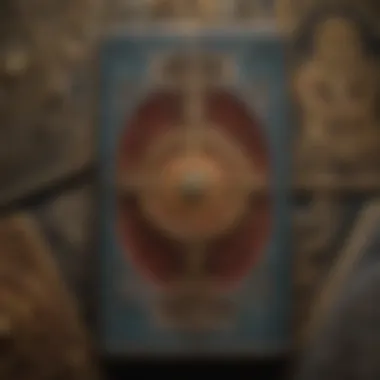

Contemporary Applications of Tarot
As the realm of tarot evolves, its contemporary applications reveal a fascinating breadth of purpose. Each card that emerges not only serves as a key to interpretation but also acts as a tool for personal growth and decision-making in today’s fast-paced world. This section will delve into the practical uses of tarot in personal development and its role in aiding individuals through the intricate landscape of their life choices. Understanding these contemporary applications offers enthusiasts insight into how tarot remains relevant amidst various societal changes.
Tarot in Personal Development
In an era where self-awareness is often seen as a stepping stone to emotional intelligence, tarot cards can be seen as mirrors reflecting one’s inner landscape. Individuals often turn to tarot as a companion on their journey of self-discovery. The cards resonate differently with each reader based on their life experiences.
- Insight into Self: Each card can trigger a deep introspective process. For instance, drawing the Strength card may compel an individual to reflect on their inner resilience and courage in the face of adversity.
- Goal Setting: Tarot can help set personal goals. A reader might focus on a specific card and ask what it reveals about their aspirations. This tactical approach can provide clarity about their next steps.
- Healing Journeys: Many find that tarot aids them in processing emotional traumas. The imagery and symbolism found in cards can serve as prompts for therapy, catalyzing important conversations within oneself or with a therapist.
Engaging with tarot in such personal contexts fosters a proactive approach to development, encouraging individuals to tap into their intuition.
Utilizing Tarot for Decision-Making
In moments of uncertainty, tarot emerges as an aide-de-camp for decision-making. This practice embodies the delicate balance between chance and choice, allowing individuals to foreground elements of their lives that often go unnoticed. Tarot holds a special place when navigating dilemmas, relationships, or professional paths.
- Clarifying Choices: Drawing cards while contemplating a decision can untangle complex thoughts. One card may illuminate the risks involved, while another highlights potential rewards, providing a balanced view.
- Articulating Feelings: Expressing what troubles the mind can often be daunting. Tarot facilitates a conversation between the conscious and subconscious. For example, the Two of Swords may prompt discussions about choices that carry emotional weight, promoting resolution through clarity.
- Interpreting Outcomes: Tarot can give glimpses into possible futures based on current trajectories. Using the Future Position in a spread, a reader might discern how certain decisions could sway outcomes, empowering individuals to navigate ahead more confidently.
"Tarot is not just about predicting the future but about understanding the present and shaping our choices with awareness."
Ultimately, the applications of tarot in personal development and decision-making underscore its value as a versatile tool. The cards, while rooted in rich history, continue to resonate with contemporary seekers. Harnessing this ancient wisdom in modern contexts yields profound insights for self-exploration and growth.
Criticism and Skepticism
When delving into the realm of tarot card reading, it is essential to engage with the concepts of criticism and skepticism. This not only provides a balanced view, but also represents the dialogues surrounding the validity of tarot as a practice. Understanding these elements fosters a deeper appreciation of both the art of reading and the psychology of those who seek guidance through the cards.
Criticism, in this context, arises from various corners—scientific communities, religious institutions, and even some veteran practitioners themselves. Examining these critiques offers valuable insights into the perceived limitations and potential misuses of tarot. Meanwhile, skepticism serves as a crucial lens through which one may question the authenticity of readings or the efficacy of tarot card interpretations.
By exploring criticisms and skeptics' viewpoints, practitioners can cultivate stronger arguments for their craft while also recognizing areas for improvement or clearer communication with the public. This helps in establishing tarot not just as a mystical endeavor, but as a meaningful and thoughtful practice.
Common Misconceptions About Tarot
There are several widespread misconceptions that often cloud the perceptions of tarot card reading. One major belief is that tarot cards predict the future with absolute certainty. Many view the cards as some sort of crystal ball, mistakenly thinking that they offer definitive answers to life's questions. In reality, tarot readings are more about guidance and insights rather than concrete forecasts.
Another common misconception involves the association of tarot with negative connotations. For instance, some think of tarot as a tool for dark magic or sorcery. This stereotype can stem from portrayals in popular media or cultural taboos. However, tarot can be a tool for self-reflection and empowerment, not merely a vessel for foreboding predictions.
There’s also a belief that you have to possess a special talent to interpret tarot cards successfully. In truth, anyone willing to learn the meanings of the cards and how to apply them to their questions can engage with tarot meanings effectively. It’s about practice, intuition, and developing a personal relationship with the deck.
"Tarot isn’t about predicting the future; it’s a mirror reflecting the present, illuminating choices available to you."
Responses to Skeptical Views
Skeptics may challenge tarot's claims by citing a lack of empirical evidence supporting the efficacy of card readings. Responses to these views often point to the subjective experience of tarot. Just as art can evoke different emotions in various viewers, tarot readings resonate on an individual basis. Each person's interaction with the cards can yield unique insights and perspectives.
Additionally, many practitioners advocate the psychological benefits of tarot. The cards can provide a structured framework for introspection, encouraging individuals to contemplate their thoughts and feelings. Research in psychology often validates the therapeutic benefits of reflective practices, similar to what tarot offers.
Practitioners can also point out how tarot fosters discussion, promoting communication around topics that might seem daunting otherwise. It creates a safe environment for exploration, where individuals can express their thoughts and feelings without judgement.
Ultimately, while criticism and skepticism are undoubtedly part of the conversation around tarot, engaging with these perspectives can enhance its credibility. This approach invites a richer understanding of tarot as not just an esoteric practice, but also a profound tool for personal development and self-discovery.
Closure: The Lasting Appeal of Tarot
As we seek to unravel the intricate tapestry that is tarot reading, we find that its significance stretches far beyond mere entertainment or mysticism. Tarot continues to captivate individuals across generations, and its lasting appeal can be attributed to several key elements that resonate deeply with both practitioners and seekers alike.
One of the primary reasons tarot endures is its dynamic nature. Unlike rigid systems of prediction or dogmatic teachings, tarot offers a flexible framework that adapts to individual experiences and intuitions. This adaptability allows practitioners to harness the cards as tools for self-reflection and exploration. Each reading becomes a dialogue between the reader and the querent, fostering a personal connection that is hard to replicate in more traditional forms of forecasting.
Additionally, the symbolic richness embedded in the tarot deck provides context for personal and collective narratives. The archetypes present in the Major Arcana and the subtleties of the Minor Arcana allow clients to project their own stories onto the cards, thus facilitating greater understanding and insight. This often leads to moments of clarity, enabling individuals to grasp circumstances or emotions they might otherwise overlook.
"Tarot is a mirror that reflects not just what is, but also what could be."
Summarizing Key Insights
To encapsulate the key insights from our exploration of tarot, one might consider these points:
- Holistic Self-Understanding: Tarot readings prioritize personal insight, fostering self-exploration that can lead to deeper emotional health.
- Utility in Diverse Contexts: The versatility of tarot allows for applications in various areas—be it personal development, relationship navigation, or professional decision-making.
- Cultural Significance: Over centuries, tarot has interwoven with numerous cultural narratives, adapting to the values and beliefs of each era while retaining core archetypal wisdom.
Future Directions in Tarot Studies
Looking ahead, the landscape of tarot studies presents intriguing possibilities. As interest in tarot continues to expand, there are several avenues researchers and practitioners might consider:
- Interdisciplinary Approaches: By integrating psychology, sociology, and art into tarot studies, professionals can provide a more rounded view of its impact on individuals and communities.
- Tech Integration: The rise of digital platforms may lead to more innovative applications of tarot, such as virtual readings or interactive apps that bring a fresh perspective to traditional practices.
- Exploring Non-Western Tarot Traditions: As practitioners delve into lesser-known tarot traditions from around the globe, the discourse surrounding the cards could deepen, reflecting a broader spectrum of human experience.
In essence, while tarot's historical roots provide a framework for understanding its past, its future seems ripe with potential. As scholars and practitioners navigate this exciting terrain, they will undoubtedly uncover new insights that mirror the shifting landscapes of human thought and experience, further solidifying tarot’s place in contemporary society.




